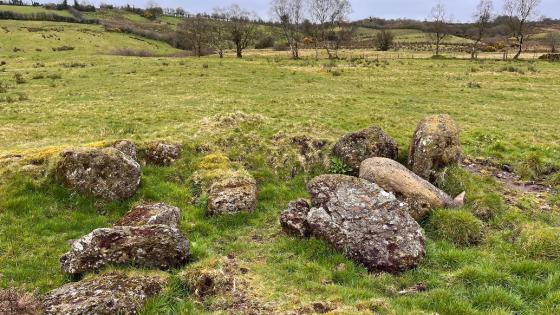Northbound on the R186 in Monaghan turns into Tyrone and the B83 at Tanderagee and the Fury river and you’d barely notice, only you do. The man with the commercial vehicle sales and service business bang on the border must be jurisdictionally flexible, elastic even. From here, as the crow flies a kilometre west, is the cat’s cairn, Carn na gCat. In rough terrain, horse shit in evidence, but no horses, precious little could have been produced since the bog grew.
But the ancestors were here. And they left us Carn na gCat, an almost symmetrical dual court tomb, embedded in a long cairn much of which remains, two metres tall in places. Partially excavated in 1899, it’s a monument in state care now, care which it seems is not easy to give lately by the looks of the growth – fortunately we’re here in winter, and we have our wellies. The fenced in track down to the site is waterlogged, the courts and chambers still not visible.
Rapidly the fences end and you’re in the court of the cats, the almost perfect north-eastern semi-circle entrance welcoming you in. The two Clontygora-esque shouldered stones flanking the jambs are striking – asymmetrical, but sure why not? But that’s where the asymmetry ends – everything after that seems planned, geometric, mirrored, until you emerge at the south-west end and its less spectacular court. Between the two courts are four chambers each roughly 2.5 metres long, two galleries separated by a gap of about a metre between the two backstones.
The four gaps between the entrance and segmenting jambstones are about the same width and each of the four chambers have four sidestones, two on each side, all pretty symmetrical, but no less satisfying for that. It’s in amazingly good condition, only now a tad overgrown, holly colonising the northern side and I’d say the whole thing might get inundated in summer. Some of the roofstones are laying about on the south-eastern flank of the tomb and there’s no sign of any corbelling – which begs the question: if the distance from the floor to the top of the chamber sidestones is never much over 1.5 metres, were the tombs built by small people, or very large cats?
We mucked about here for quite a while in the watery winter sunshine, our first stop on a quick gallop around South Tyrone and we were enchanted, glad to be back out exploring, discovering, snooping and wondering. It was a great place to start at and is definitely worth a visit, only let’s hope that now things are recovering that the DOE tend to the plants that are in danger of taking over the place.




















